Fractions
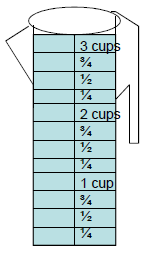
Fractions are a form of division.
When I ask what is 3/4 I am asking “How
big will each part be if I break 3 into 4
equal parts?”
The answer is ¾ . This a fraction. A
fraction is part of a whole. The top part
of the fraction is the numerator and the
bottom part is the denominator.
Since 3 < 4 this is a proper fraction
because the numerator is less than the
denominator.
In an improper fraction, the numerator is
greater than or equal to the denominator,
such as 4/3, or 3/3.
Proper fractions have values less than 1
and improper fractions have values
greater than or equal to 1.
| 1 whole cup is divided into4 equal parts. ¾ cup is 3 of those 4 equal parts. |
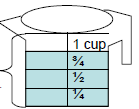 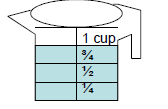 |

Writing a Fraction in Lowest Terms
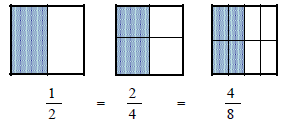
Notice the same size box is split three different ways in
equal parts:
in 2 parts, 4 parts, or 8 parts.
By looking at the pictures, each box has the same portion
(or fraction)
filled, so these portions are called equivalent fractions .
Fundamental Property of Fractions
Multiplying or dividing the numerator AND the denominator
of
a fraction by the same nonzero number (not 0) does not change
the value of the fraction. The fractions are equivalent.

A Fraction in Lowest Terms
Means the numerator and denominator have no common
factor other than 1. The denominator is the lowest it can be.
4/8 is not in lowest terms because 4 and 8 have common
factors: 2 and 4.
2 goes into both the numerator,4, and the denominator, 8, and 4 also
goes into both 4 and 8.
2/4 is not in lowest terms because 2 and 4 have a common
factor :2.
2 goes into both the numerator,2, and the denominator,4.
½ is in lowest terms because there is no number (factor)
that goes into
both the numerator, 1, and the denominator, 2, other than 1.
Do self-check: Are the following fractions in lowest
terms?
a) 4/5 b) 6/18 c) 9/15 d) 17/46
Using Greatest Common Factor (GCF) to reduce a fraction
to its
lowest terms
The Greatest Common Factor is the largest number that goes
into two numbers
What is the GCF of 20 and 24? The largest number that goes
into both 20 and 24 (the largest divisor of both 20 and 24)
Both numbers are divisible by 2. Is 2 the GCF?
20÷2 = 10, and 24÷2 = 12. But 10 and 12 have common factors,
so 2 is not the GCF of 20 and 24.
A bigger number can go into both 20 and 24.
4 is the GCF of 20 and 24. 20÷4 = 5, and 24÷4 = 6.
5 and 6 have no common factors, so 4 is the GCF.
To reduce a fraction to its lowest terms, find the GCF of
the
numerator and the denominator, and divide both the
numerator and denominator by the GCF.

so 5/6 is 20/24 in its lowest terms.
Example 3 on p. 225
If you write the prime factorization both the numerator and
denominator, the fraction in lowest terms is easily found by
cancelling out the common prime factors.
Write 90/126 in lowest terms.
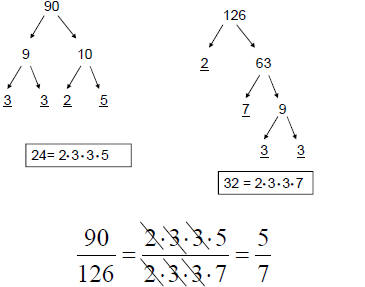
You can only cancel out factors on the bottom
(denominator) with corresponding factors on the top
(numerator).
Example 4 on p.225
Simplify:

To simplify, we simply divide both the numerator and the
denominator by the greatest common factor.
What is the greatest common factor of 24xy2 and 16x2y2?
Let’s rewrite these algebraic expressions by breaking them up.

We can reduce this fraction by dividing both the numerator
and
denominator by the greatest common factor. Let’s just work
with the coefficients first . What is the GCF of 24 and 16?
I.e., that is the biggest number that goes into both 24 and 16?
The GCF of 24 and 16 is 8. 24/8 = 3 and 16/8 = 2.
Now, what is the greatest common factor of
x●y ●y and x ●x ●y ●y? GCF is 8x ●y ●y
Circle the groups of common variables.

Expressing a fraction in higher terms:
Later when we add fractions , we might have to express
them in higher terms so that each fraction will have the same
denominator.
Example 5 p276 Write 5/7 as an equivalent fraction with a
denominator of 28.
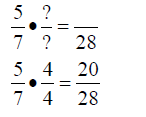
Example 5 p276 Write 4 as an equivalent fraction with a
denominator of 6. Is 4 a fraction? We can make it one by
writing it as 4/1.
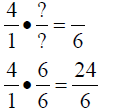
Multiplying fractions is easy: you multiply the top
numbers and
multiply the bottom numbers. For instance:

When possible, you reduce. In this case, however, nothing
reduces,
because 8 and 45 have no factors in common. If you're not sure, you
can always do prime factorization:

Nothing cancels.
Often, though, something will cancel:
·Simplify

Dividing fractions is just about as easy; there's just one
extra step .
When you divide by a fraction, the first thing you do is "flip-n-multiply".
That is, you take the second fraction, flip it upside-down,
and multiply it by the first fraction. (The upside-down fraction is

| Prev | Next |